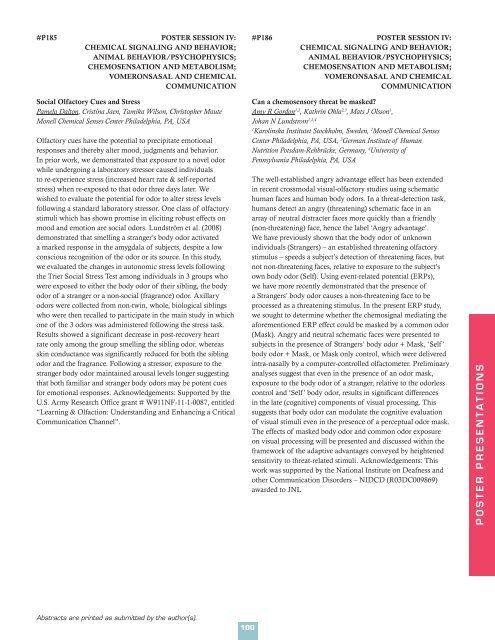Abstracts - Association for Chemoreception Sciences
Abstracts - Association for Chemoreception Sciences
Abstracts - Association for Chemoreception Sciences
Create successful ePaper yourself
Turn your PDF publications into a flip-book with our unique Google optimized e-Paper software.
#P185 POSTER SESSION IV:<br />
CHEMICAL SIGNALING AND BEHAVIOR;<br />
ANIMAL BEHAVIOR/PSYCHOPHYSICS;<br />
CHEMOSENSATION AND METABOLISM;<br />
VOMERONSASAL AND CHEMICAL<br />
COMMUNICATION<br />
#P186 POSTER SESSION IV:<br />
CHEMICAL SIGNALING AND BEHAVIOR;<br />
ANIMAL BEHAVIOR/PSYCHOPHYSICS;<br />
CHEMOSENSATION AND METABOLISM;<br />
VOMERONSASAL AND CHEMICAL<br />
COMMUNICATION<br />
Social Olfactory Cues and Stress<br />
Pamela Dalton, Cristina Jaen, Tamika Wilson, Christopher Maute<br />
Monell Chemical Senses Center Philadelphia, PA, USA<br />
Olfactory cues have the potential to precipitate emotional<br />
responses and thereby alter mood, judgments and behavior.<br />
In prior work, we demonstrated that exposure to a novel odor<br />
while undergoing a laboratory stressor caused individuals<br />
to re-experience stress (increased heart rate & self-reported<br />
stress) when re-exposed to that odor three days later. We<br />
wished to evaluate the potential <strong>for</strong> odor to alter stress levels<br />
following a standard laboratory stressor. One class of olfactory<br />
stimuli which has shown promise in eliciting robust effects on<br />
mood and emotion are social odors. Lundström et al. (2008)<br />
demonstrated that smelling a stranger’s body odor activated<br />
a marked response in the amygdala of subjects, despite a low<br />
conscious recognition of the odor or its source. In this study,<br />
we evaluated the changes in autonomic stress levels following<br />
the Trier Social Stress Test among individuals in 3 groups who<br />
were exposed to either the body odor of their sibling, the body<br />
odor of a stranger or a non-social (fragrance) odor. Axillary<br />
odors were collected from non-twin, whole, biological siblings<br />
who were then recalled to participate in the main study in which<br />
one of the 3 odors was administered following the stress task.<br />
Results showed a significant decrease in post-recovery heart<br />
rate only among the group smelling the sibling odor, whereas<br />
skin conductance was significantly reduced <strong>for</strong> both the sibling<br />
odor and the fragrance. Following a stressor, exposure to the<br />
stranger body odor maintained arousal levels longer suggesting<br />
that both familiar and stranger body odors may be potent cues<br />
<strong>for</strong> emotional responses. Acknowledgements: Supported by the<br />
U.S. Army Research Office grant # W911NF-11-1-0087, entitled<br />
“Learning & Olfaction: Understanding and Enhancing a Critical<br />
Communication Channel”.<br />
Can a chemosensory threat be masked?<br />
Amy R Gordon 1,2 , Kathrin Ohla 2,3 , Mats J Olsson 1 ,<br />
Johan N Lundstrom 1,2,4<br />
1<br />
Karolinska Institutet Stockholm, Sweden, 2 Monell Chemical Senses<br />
Center Philadelphia, PA, USA, 3 German Institute of Human<br />
Nutrition Potsdam-Rehbrücke, Germany, 4 University of<br />
Pennsylvania Philadelphia, PA, USA<br />
The well-established angry advantage effect has been extended<br />
in recent crossmodal visual-olfactory studies using schematic<br />
human faces and human body odors. In a threat-detection task,<br />
humans detect an angry (threatening) schematic face in an<br />
array of neutral distracter faces more quickly than a friendly<br />
(non-threatening) face, hence the label ‘Angry advantage’.<br />
We have previously shown that the body odor of unknown<br />
individuals (Strangers) – an established threatening olfactory<br />
stimulus – speeds a subject’s detection of threatening faces, but<br />
not non-threatening faces, relative to exposure to the subject’s<br />
own body odor (Self). Using event-related potential (ERPs),<br />
we have more recently demonstrated that the presence of<br />
a Strangers’ body odor causes a non-threatening face to be<br />
processed as a threatening stimulus. In the present ERP study,<br />
we sought to determine whether the chemosignal mediating the<br />
a<strong>for</strong>ementioned ERP effect could be masked by a common odor<br />
(Mask). Angry and neutral schematic faces were presented to<br />
subjects in the presence of Strangers’ body odor + Mask, ‘Self’<br />
body odor + Mask, or Mask only control, which were delivered<br />
intra-nasally by a computer-controlled olfactometer. Preliminary<br />
analyses suggest that even in the presence of an odor mask,<br />
exposure to the body odor of a stranger, relative to the odorless<br />
control and ‘Self’ body odor, results in significant differences<br />
in the late (cognitive) components of visual processing. This<br />
suggests that body odor can modulate the cognitive evaluation<br />
of visual stimuli even in the presence of a perceptual odor mask.<br />
The effects of masked body odor and common odor exposure<br />
on visual processing will be presented and discussed within the<br />
framework of the adaptive advantages conveyed by heightened<br />
sensitivity to threat-related stimuli. Acknowledgements: This<br />
work was supported by the National Institute on Deafness and<br />
other Communication Disorders – NIDCD (R03DC009869)<br />
awarded to JNL<br />
POSTER PRESENTATIONS<br />
<strong>Abstracts</strong> are printed as submitted by the author(s).<br />
100
















